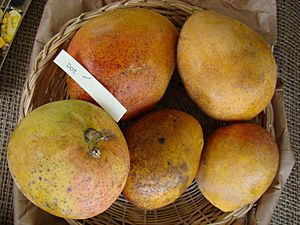Dot (mango) facts for kids
Quick facts for kids Mangifera 'Dot' |
|
|---|---|

Dot mangoes
|
|
| Genus | Mangifera |
| Hybrid parentage | 'Zill' × unknown |
| Cultivar | 'Dot' |
| Breeder | Laurence Zill |
| Origin | Florida, USA |
The Dot mango is a special kind of mango that first grew in South Florida, USA. It's not usually grown in big farms for selling in stores, but many people like to grow it in their own backyards in Florida. It's known for its delicious taste!
The Story of the Dot Mango
The Dot mango was first created by a plant expert named Laurence Zill. He had a nursery in Boynton Beach, Florida. He named this mango after his wife, Dorothy.
At first, people thought the Dot mango came from a mango called 'Carrie'. But later, in 2005, scientists looked closely at its family tree. They found out it was more likely a seedling (a plant grown from a seed) of the 'Zill' mango.
The Zill nursery grew the Dot mango for a few years. However, it became less popular because it could easily get plant diseases. Also, its skin color wasn't always as bright as other mangoes.
Then, a man named Frank Smathers from Miami, Florida got some pieces of the Dot mango tree. He started growing them himself. He discovered that the fruit tasted really, really good!
Because of Frank Smathers, the Dot mango started to become popular again. In 1992, it was featured at the International Mango Festival. This festival takes place at the Fairchild Tropical Botanic Garden in Florida. Since then, the Dot mango has been a favorite at the festival many times.
Today, you can still buy Dot mango trees to plant in your yard in Florida. These trees are also kept in special plant collections. You can find them at the USDA's plant bank in Miami, Florida. They are also at the University of Florida's Tropical Research and Education Center in Homestead, Florida. And you can see them at the Miami-Dade Fruit and Spice Park, also in Homestead.
What Does the Dot Mango Look Like?
The Dot mango fruit has an oval shape. It's a bit pointy at one end. Each fruit usually weighs a little less than one pound (about 450 grams) when it's ready to eat.
When ripe, the skin of the Dot mango is yellow. It often has a pretty pink blush on it. Inside, the fruit is juicy and firm. It has no stringy fibers, which is great! It also smells wonderful and tastes very rich and sweet.
The seed inside the Dot mango is called monoembryonic. This means it usually grows only one plant from each seed.
Dot mangoes are ready to pick from June to August in Florida. This gives them a long harvest time. However, the fruit and flowers can sometimes get a fungus called anthracnose. This can make it harder for the trees to produce a lot of fruit.
The Dot mango trees grow at a medium speed. They have open branches, which means the sunlight can reach the fruit easily. Their leaves often look a bit yellow, even when the tree is perfectly healthy.

